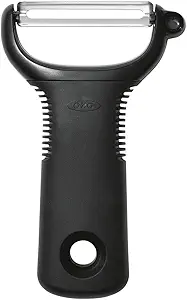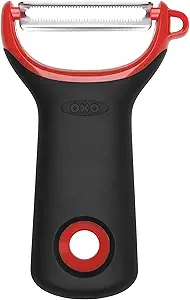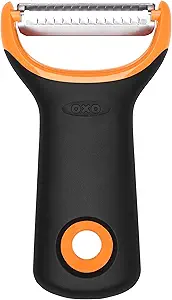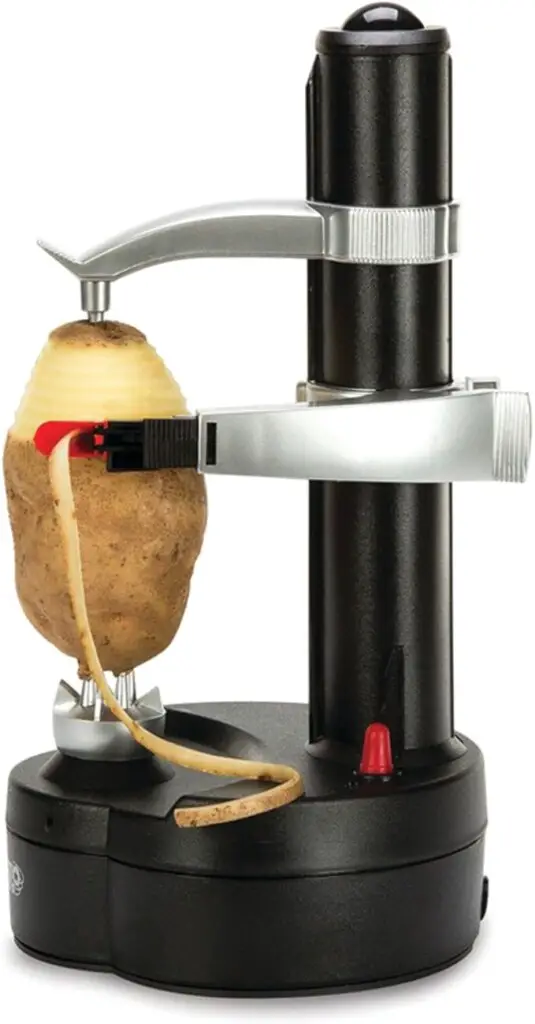There are several different types of fruit and vegetable peelers available today. Some peelers are optimized for specific produce items and others can handle a variety of jobs.
In this guide, we’re going to cover the 9 primary types of peelers, as well as 4 tools that I wouldn’t quite call a peeler, but still do the job.
The 9 types of peelers are swivel peeler, Y peeler, serrated peeler, julienne peeler, finger peeler, Lancashire peeler, hand-crank rotary peeler, electric rotary peeler, and multi-blade peeler. There are also a few other kitchen utensils that can be used to peel fruits and veggies that aren’t peelers.
But how do you know which peeler to use for which thing? A lot of it comes down to personal preference, bu there are certain things that each peeler is best suited for.
Let’s jump in!
Disclaimer: This post contains affiliate links. This means I may earn a commission should you choose to make a purchase using my link
Table of Contents
We’ll go over each peeler one by one, but if you want a quick glance to go on your way, here’s a table that outlines what peelers are the best for what kinds of jobs.
| Best Peelers | For These Tasks/Needs |
| Swivel | Long vegetables: Carrots, parsnips, asparagus, broccoli |
| Y-shaped | Hard items: Sweet potatoes, butternut squash, and apples. |
| Y-shaped, rotary | Speed |
| Serrated | Soft items: Tomatoes, eggplant, etc. |
| Multi-blade, paring knife | Versatility |
| Palm, rotary | Ergonomics |
| Palm, rotary | Children |
| Julienne, spiralizer | Thin strips, or veggie “noodles” |
| Zester/grater | Citrus zest |
| Garlic peeler | Garlic |
| Lancashire, zester/grater | Ginger |
Now let’s get into each type so you know every possible detail about peelers that you could want.
1. Swivel Peeler or Jonas Peeler
OXO Swivel Peeler on Amazon. (Note: we receive commissions on qualifying Amazon purchases).
First off, we have swivel peelers (also called “Jonas” peelers).
Swivel peelers are probably the first style that comes to mind when you think “vegetable peeler”.
They are straight peelers with a double blade that extends from the handle and swivels with pressure to keep the blades skimming along the skin of fruits and vegetables.
Pros:
- Best for long vegetables such as carrots, parsnips, asparagus, and broccoli stems, or for smaller firm vegetables such as medium or small potatoes.
- Can also handle firm produce such as potatoes, sweet potatoes, butternut squash, and apples.
- Usually has potato eye remover at the tip.
Cons:
- Challenging on softer produce such as citrus, tomatoes, and eggplant.
2. Y or Swiss or Speed Peeler
OXO Y Peeler on Amazon. (Note: we receive commissions on qualifying Amazon purchases).
The Y-shaped peeler is also known as a Swiss or Speed Peeler.
This peeler looks like a slingshot and the blade swivels with pressure.
If you already have a peeler in your home, and it’s not a swivel peeler, then there’s a good chance that it’s a Y peeler.
Pros:
- Best for larger firm vegetables such as big potatoes, sweet potatoes, butternut squash, and apples.
- Can also handle smaller potatoes, sweet potatoes, and apples, or thin vegetables like carrots, parsnips, and asparagus.
- The Y Peeler is a favorite of professional chefs because the wide span of the handle increases control.
- It’s also faster to use, once you get the hang of it.
Cons:
- Challenging on softer produce such as soft citrus, tomatoes, and eggplant.
- May (or may not) have potato eye remover.
- It may take a while to get the knack of this peeler. Watch the video below to see a quick (less than 1 min) demo of good technique.
3. Serrated Peeler
OXO Serrated Y Peeler on Amazon. (Note: we receive commissions on qualifying Amazon purchases).
Serrated peelers come in both straight swivel and Y-handle models.
They are exactly like their straight-bladed cousins except for the serrated blade.
If you’re wondering why this seemingly small variation exists, the main advantage of a serrated peeler is how well it works on soft produce.
Pros:
- The serrated peeler is the only one that works well on softer, thin-skinned produce.
- Best for softer fruits and vegetables such as peaches, tomatoes, and eggplants.
Cons:
- The serrated peeler is not very versatile.
- Challenging for more firm produce, since this peeler may not glide as easily as the straight-edged peelers
4. Julienne Peeler
OXO Julienne Y Peeler on Amazon. (Note: we receive commissions on qualifying Amazon purchases).
A Julienne peeler is an interesting variation of the peelers we’ve looked at so far.
It looks a lot like a serrated peeler, but the blades themselves have larger “spikes” that are spaced further apart which is called a julienne blade.
This allows the Julienne peeler to turn a vegetable (like a zucchini, or carrot), into thin strips that can be used as veggie noodles or in a salad, etc.
Pros:
- Great for making veggie “pasta” like zoodles or veggie strips for salads
Cons:
- If you just want to peel veggies (and not put them into strips) then you’re better off with a different peeler
5. Finger / Palm / Hand Peeler
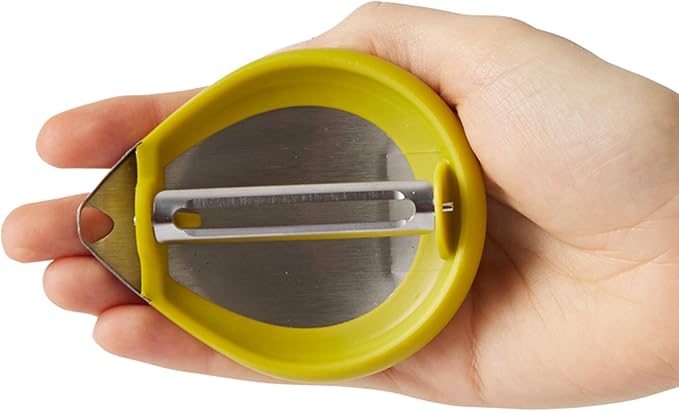
Chef’n Palm Peeler on Amazon. (Note: we receive commissions on qualifying Amazon purchases).
This peeler goes on like a ring, and then the blade is on the inside of the plastic covering.
This is a great peeler if you’re looking for a more ergonomic option, but don’t want to use a rotary peeler (see below)
It allows you to peel fruits and vegetables without gripping a handle. You can also get a variation of this tool that is designed for zesting (e.g. for citrus).
Pros:
- The palm peeler enables peeling without gripping a handle.
- Some versions have two rings, which might be even more comfortable for some hands.
Cons:
- You cannot see exactly where you are peeling.
6. Lancashire Peeler
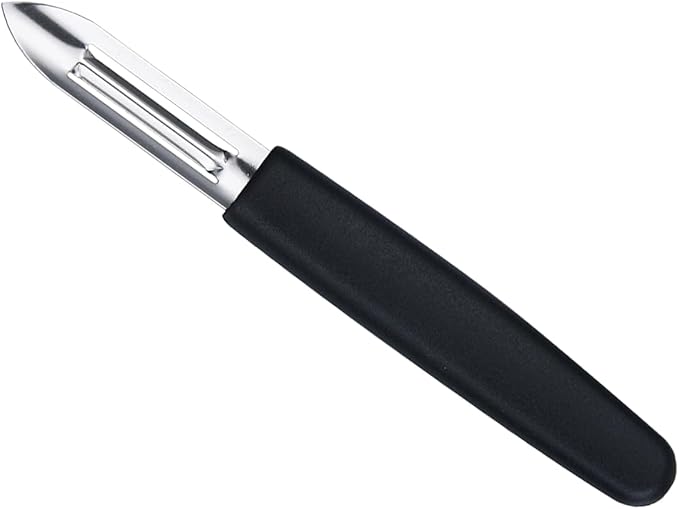
Mercer Lancashire Peeler on Amazon. (Note: we receive commissions on qualifying Amazon purchases).
The Lancashire peeler looks similar to a swivel peeler except that the blade part extends from the handle and remains rigid.
This peeler is named after the Lancashire region in the United Kingdom, which was known for growing potatoes. Because of this, it also has a potato eye remover on the tip of the peeler.
Traditionally the grip is wrapped with string although many models no longer have this feature.
Pros:
- Best for any size of firm vegetable or fruit, big and round to small and narrow.
- Very good for ginger root and citrus.
- Gives you more control than a swivel peeler.
- Very versatile.
Cons:
- Challenging on softer produce such as citrus, tomatoes, and eggplant.
- May cause wrist strain if there is a lot of peeling.
- If it has a string-wrapped handle it may not be dishwasher safe.
7. Hand-Crank Rotary Peeler
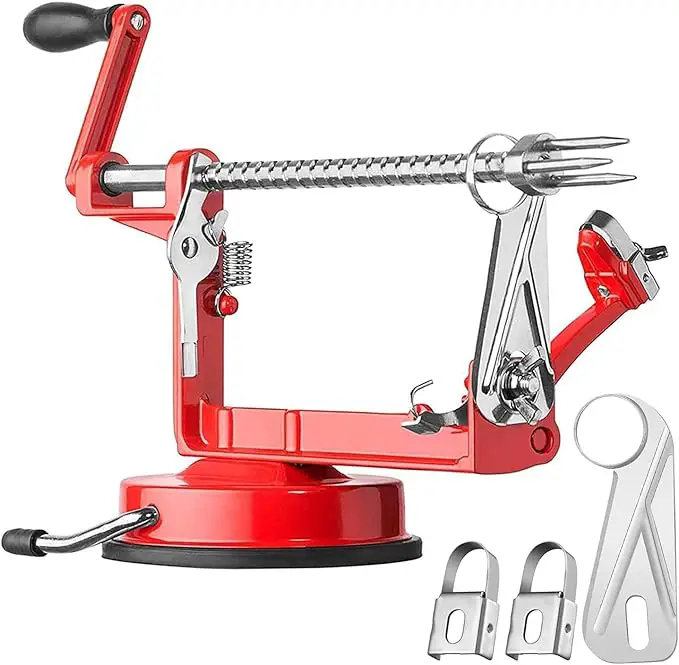
Spiralizer Rotary Peeler on Amazon. (Note: we receive commissions on qualifying Amazon purchases).
This is the first mechanical, and not handheld, type of peeler on this list.
To use these industrial-looking gadgets you plug the apple (or other firm produce) onto a post, turn the crank, and the peel comes off in one long spiral strip.
These are a great option if you’re planning to peel a large amount of potatoes, apples, or other firm produce.
Pros:
- Even very young children can turn the crank.
- Cleaning up the peels is a snap.
- Best for large volumes of apples or potatoes.
Cons:
- Must be anchored to a table or counter.
- Takes longer to clean than handheld peelers.
- Takes up more room.
8. Electric Rotary Peeler
Spiralizer Rotary Peeler on Amazon. (Note: we receive commissions on qualifying Amazon purchases).
This is essentially the same as the Hand-Powered Rotary Peeler except it doesn’t require elbow grease.
If you’re deciding between an electric and crank peeler, the electric model is going to take less effort.
However, an electric peeler is a little more expensive and will probably not last as long as a crank model, given the extra electrical components.
Pros
- Easy to Use
- Good option for people with arm or wrist problems
Cons
- Takes electricity
- More expensive vs most other peelers
- May not last as long as other peelers, given the electrical components
9. Multi-Blade Peelers: 2-in-1, 3-in-1 and 4-in-1
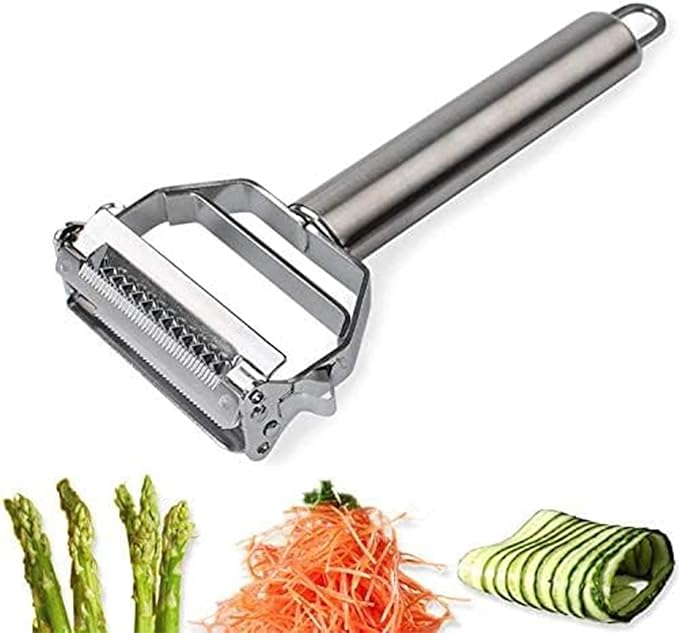
Angeer Julienne and Vegetable Peeler on Amazon. (Note: we receive commissions on qualifying Amazon purchases).
In addition to individual peeling tools, you can also find multi-function peeling tools.
For example, in the image, we’re showing a tool that you can use as both a Julienne (see above) and a vegetable peeler.
It’s worth noting, that you can also find multi-pack products, where each tool serves a specific function, but the bundle contains a variety of different peeling tools.
Pros:
- Versatility
- Can reduce clutter by having less individual tools
Con:
- Might be harder to clean.
- Could be more difficult to use than individual tools depending on the design
- A bit of a gimmick (in my opinion)
Similar Tools, But Not Quite Peelers
In addition to the peeling tools mentioned above, there are some other tools that aren’t quite in the “peeler” category but are in a very closely related group. Here are a few highlights:
Paring Knife
Henckels paring knife on Amazon. (Note: we receive commissions on qualifying Amazon purchases).
I almost included this on the list of “proper” peeler tools above.
This is a traditional kitchen staple and, in all honesty, this is what I use to peel vegetables more than a traditional peeler.
If you have a minimalist kitchen, can’t find the right peeler, or are going to use this knife for another task anyway, the paring knife is a great tool for peeling.
Spiralizer
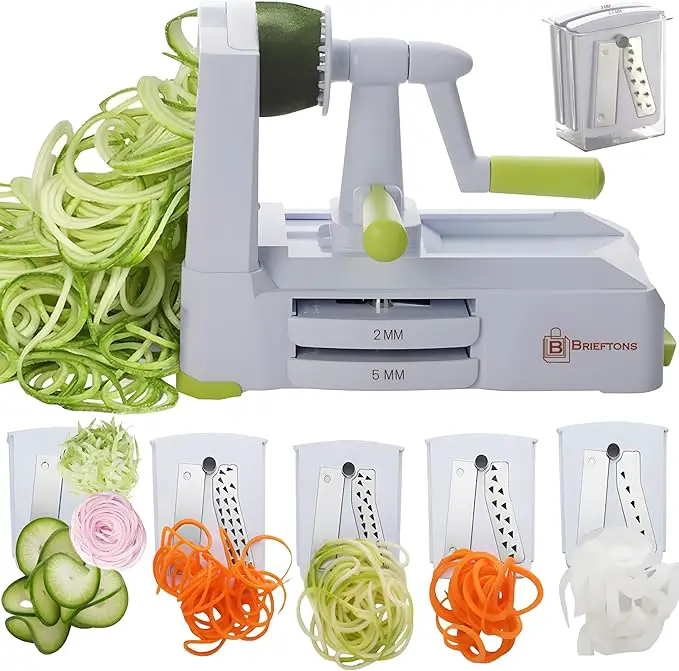
Spiralizer 5-blade vegetable slicer on Amazon. (Note: we receive commissions on qualifying Amazon purchases).
A Spiralizer is like a Julienne peeler on steroids.
These tools look like Rotary Peelers but produce very long veggie “noodles”.
One of the most popular veggies to use for these “noodles” is zucchini, which is fairly soft and not too hard to crank.
You can also theoretically do harder vegetables like sweet potatoes, but that would be quite the workout with a hand crank.
Zester / Grater
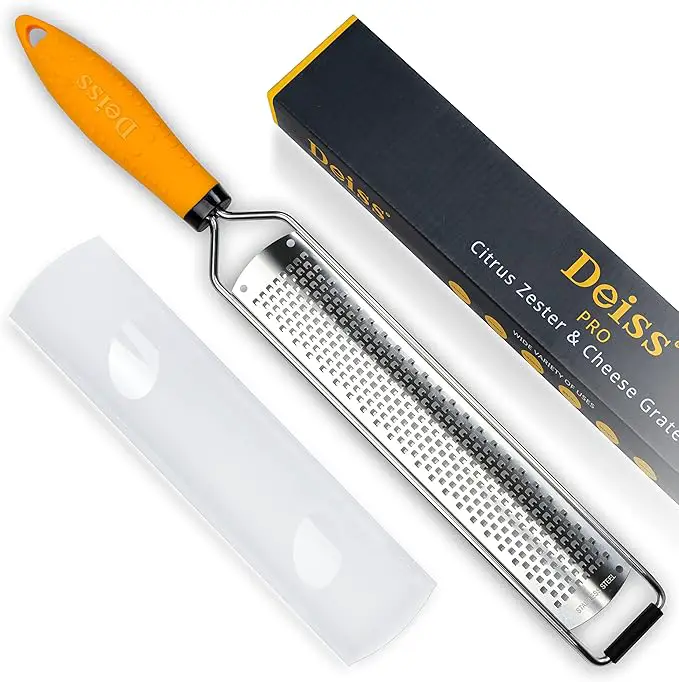
Deiss zester / grater on Amazon. (Note: we receive commissions on qualifying Amazon purchases).
It’s not quite a peeler, but it can be used on the peels of citrus (like lemons and oranges) for zesting.
I also use a zester like this to grate garlic and ginger instead of having to finely chop them with a knife.
This type of tool can also be used as a cheese grater (think Parmesan on pasta).
All around, a grate (see what I did there) tool to have in your kitchen.
Garlic Peeler
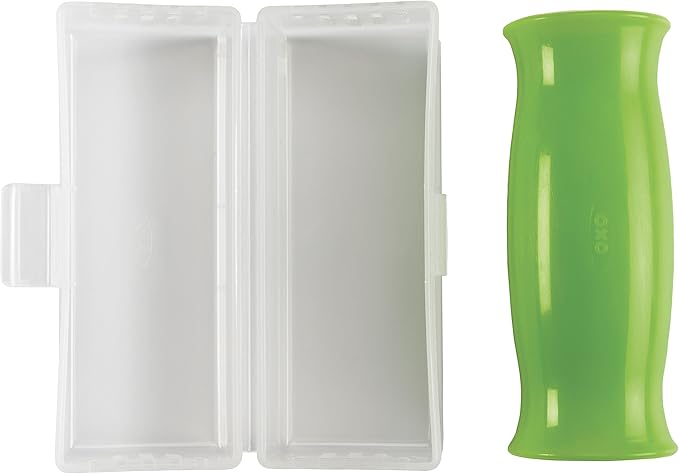
OXO garlic peeler on Amazon. (Note: we receive commissions on qualifying Amazon purchases).
Technically, this IS a peeler, but it only works for garlic, and it doesn’t work like the other more traditional peelers above.
Garlic peelers are small silicone tubes designed specifically to rub the layers of skin off of a garlic clove.
As a plus, your fingers won’t smell like garlic – or at least not as much. And using this tool will probably make peeling garlic faster for you.
FAQs About Peeling Fruits And Vegetables
Do I need to wash my produce before peeling it?
You should wash produce before peeling it. Otherwise, germs and pesticides will get on your hands and on the blades of peelers and knives, which will touch the inner surfaces of the food.
For information about washing produce, see The Food Network’s article here and the USFDA’s article here.
Do all peelers work for left-handed people?
Nearly all peelers work for left-handed people, but it is worth checking individual models. For example, a mechanical rotary peeler may be awkward if you are left-handed.
What if I have many pounds of tomatoes or peaches to peel all at once?
To peel large volumes of tomatoes or peaches, you can follow these steps:
- Wash them
- Set up a big pot of boiling water and a big tub of ice water
- Cut an X on the bottom of each tomato or peach
- Drop them in batches into the boiling water for 30 seconds
- Transfer them to the ice bath
- Then, you should be able to peel the skin right off
If you decide to use these steps, be careful not to burn yourself, and make sure the peaches/tomatoes are cool to the touch before you try peeling them.


